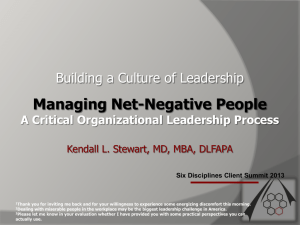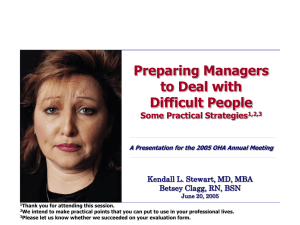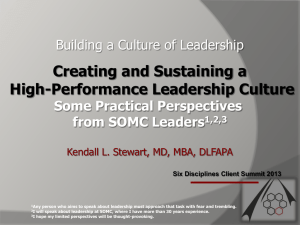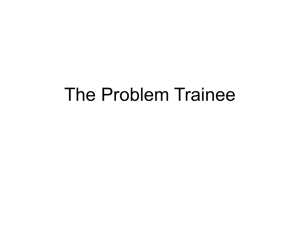Managing Net-Negative Employees
advertisement
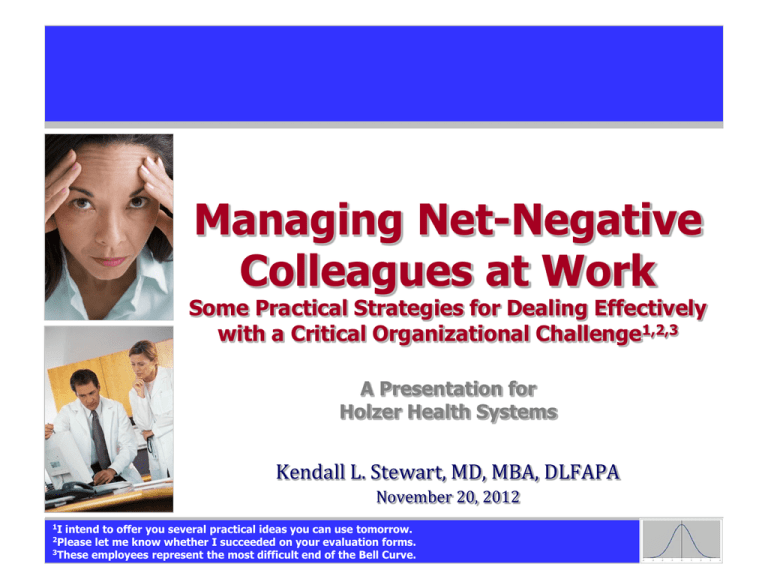
Managing Net-Negative Colleagues at Work Some Practical Strategies for Dealing Effectively with a Critical Organizational Challenge1,2,3 A Presentation for Holzer Health Systems Kendall L. Stewart, MD, MBA, DLFAPA November 20, 2012 1I intend to offer you several practical ideas you can use tomorrow. let me know whether I succeeded on your evaluation forms. 3These employees represent the most difficult end of the Bell Curve. 2Please Why is this important? • Leaders exist to produce exceptional results. • Net-negative employees are the second most important obstacle to our success. • The first obstacle is our own failure to identify and appropriately manage these people. • This presentation will enable you to – Identify them, and – Manage them expertly. • This presentation will not make this easy. • But it will show you the way.1,2 1As 2A • After listening to this presentation, you will be able to answer the following questions: – How do net-negative employees behave? – What are some of the myths about these people? – What are some of the barriers to managing net-negative people? – What are three practical strategies for managing them successfully? – Why should you follow this process? – How can you do it? a psychiatrist, I am very good at figuring out what is wrong and what needs to be done. woman consulted me for anxiety but declined to follow my advice. How do exceptional colleagues behave? • • • • • • • • • They come to work early and stay late without complaining. They view problems as opportunities to improve. They are positive by nature, but they are realistic. They tell the truth even when it hurts. They talk to others instead of talking about others. You are always happy to see them on the schedule. They disagree agreeably. They follow the rules—even when no one is watching. Just running into them makes your day. 1Miserable 2A cusses have always inspired me. man went to apply for social security but forgot his wallet. • • • • • • • • • They do not expect special treatment. They are passionate about achieving and sustaining exceptional results. They are open to change when it makes sense. They ask and answer the hard questions. They are always seeking to learn, grow and improve. They routinely go the extra mile. Their enthusiasm is infectious. They have fun. Slackers and miserable cusses despise them.1,2 How do average colleagues behave? • • • Their attendance is fair-to-good. They are loyal most of the time. They are easily influenced by the whiners. They complain about problems, but they don’t usually suggest solutions. They usually follow the rules—if they know someone might be watching. They want everybody to be happy. They want things to go well, and they believe that is the manager’s job. They don’t mix work and home— except at work. They want to know exactly what is expected of them. • • • • • • 1We 2A all long for magical transformations. farmer and his son saw an elevator for the first time. • • • • • • • • They like to learn—if it’s fun, easy and quick. They are positive—when they are around positive people. They work to live; they do not live to work. They do what they have to do and sometimes go above and beyond.1,2 They are caring, kind and goodhearted. They are easily distracted. They need extra attention, encouragement and support. They hate being put in the middle, but that is where they live. How do net-negative colleagues behave?1,2 • • • • • • • • • They are negative and miserable most of the time. They bring others down. They complain and whine. They point out problems in a negative way. They undermine their leaders. They are often hardworking and contemptuous of those who don’t share their passions and perspectives. They live to game the system and get their way. They stir the pot behind the scenes. They talk about people instead of to them. 1Knowing 2If • • • • • • • • what you now know, would you hire this person again? you would not, this person is net-negative. (Studer, 2008) They are often intelligent and skilled clinicians—and bitterly dismissive of the idiots they have to work with. They expect special treatment— because they are special. They are passive-aggressive. They love the “We-They” position. They are cynical and disparage all efforts to improve as “crap.” They believe they can outlast the leader—and they often do. They only follow the rules they like. They take nonverbal contemptuous communication to a whole new level. What are some of the myths about net-negative colleagues? • They can be safely ignored. • No one pays any attention to them anyway.1,2 • They enjoy being miserable. • They will eventually leave on their own. • They are bad people. • They bring a helpful difference of opinion. • You can’t get by without them. • You can’t afford to get rid of them until you find replacements. • They never change. 1Some 2A people appear to be genetically predisposed to be miserable. Georgia farmer complained about his wife’s weight. What are some of the barriers to managing net-negative colleagues? • Confronting them is very unpleasant. • They are frequently the best workers you’ve got. • They are so secretive it’s hard to get the goods on them. • Their colleagues complain about them, but won’t take a stand. • When under fire, they can behave perfectly until you move on to something else. • They always have a reason for acting the way they do. • It’s always someone else’s fault.1,2,3 • They are usually opinion leaders. • They are often powerful or politically wellconnected. 1A surgeon stomped out of surgery because some equipment didn’t work. I called him about his patients who were waiting, he only wanted to discuss the equipment malfunction. 3Another surgeon came in to complain that the Director of Surgical Services wouldn’t speak with him. 2When What practical process will enable you to manage net-negative colleagues effectively?1,2 • • • • • • • • • Make the case for getting serious about this to your executives and board. Obtain their unqualified support. Identify the net-negative employees. Set a deadline for completing the initial confrontation and its documentation. Make an appointment with the employees. Make it clear this appointment will be about their job performance. Inform the employees that you need to speak frankly but that you do not wish to be hurtful. Ask them to listen without interrupting until you have finished. Make notes, use them and stick to them. • • • • • • • • • • • 1Our 2This Inform these employees that you currently view them as net-negative. Explain what that term means. Detail the behaviors that have caused you to reach that conclusion. Make it clear that unless they change these behaviors permanently, they will lose their jobs. Tell them that it was your goal to let them know exactly where they stand. Ask them if you succeeded. Invite their clarifying questions. Do not allow yourself to be distracted. Send them a letter immediately documenting exactly what you said. Submit your documentation to your HR leader. Monitor those employees who remain (and their leaders!) indefinitely. process is to follow the process; if we don’t have a process, our process is to design and deploy a process. is the slide you may want to print and post in your office. Why should you tackle this challenge? • It is a real problem. • Dealing with it is hard; your willingness to step up will give your organization a clear competitive advantage.1,2 • You will decrease the turnover of your netpositive people. • You will increase morale immediately. • You will increase your credibility as a leader. • You will send a strong message to those leaning to the negative side. • You will create the kind of organizational culture that produces results. • You will attract better people to the organization. 1I have had the opportunity to confront powerful colleagues several times in my career. this opportunity arises, you will be amazed at how fellow leaders head for the hills. 2When How can you do it?1,2 • Get all the key leaders in the room. • Admit this is a serious problem. • Admit to each other how you have put this off and how much you would like to keep on avoiding dealing with the problem. • Extract a commitment from everyone to deal with this and to see it through. • Agree on the process. • Agree on timelines. • Follow the process. • Hold yourselves and other leaders accountable. • Watch for leaders to “decide” that the netnegative people are no longer net-negative. 1Let me describe how SOMC leaders actually did this. August 2008, we have identified 9.9% of our workforce as net-negative, and 49.3% have terminated. (Noel, 2012) 2Since What have we learned? • Most of us harbor net-negative people in our organizations. • They are cancers and they are metastasizing. • Unchallenged, they will kill your organizational will to succeed. • These are not easy problems to fix. • But you can and must address them. • Following a fair and proven process—in spite of the way you feel—is the answer.1,2,3 • Their victims will thank you for it. 1Leaders absolutely cannot allow their feelings to call the shots. experienced deep regret about my decision to move to Portsmouth. 3Then I heard the voice of God in Kmart. 2I Where can you learn more? • • • • • • • Join the discussion about practical approaches to more effective leadership on the SOMC Leadership Blog. Learn more about Southern Ohio Medical Center here. Review and download this presentation and related presentations and white papers here. Read Results That Last: Hardwiring Behaviors That Will Take Your Company to the Top to review some leadership strategies that successful health care executives have embraced. Learn more about how to confront others effectively by reading A Portable Mentor for Organizational Leaders. Review practical techniques for conducting crucial conversations in Crucial Conversations: Tools for Talking When Stakes are High. Consider adding the practical and comprehensive Successful Manager’s Handbook to your personal library. How can you contact me?1 Kendall L. Stewart, M.D. VPMA and Chief Medical Officer Southern Ohio Medical Center Chairman & CEO The SOMC Medical Care Foundation, Inc. 1805 27th Street Waller Building Suite B01 Portsmouth, Ohio 45662 740.356.8153 StewartK@somc.org KendallLStewartMD@yahoo.com www.somc.org www.KendallLStewartMD.com 1Speaking and consultation fees benefit the SOMC Endowment Fund. Are there other questions?1,2,3 1Here Safety Quality Service Relationships Performance are the SOMC leaders who oversee this innovative process. They would welcome your questions. Noel, VP for HR and Organizational Development, NoelV@SOMC.org 3Kendall Applegate, Director of Human Resources, AppgateK@SOMC.org 2Vicki

